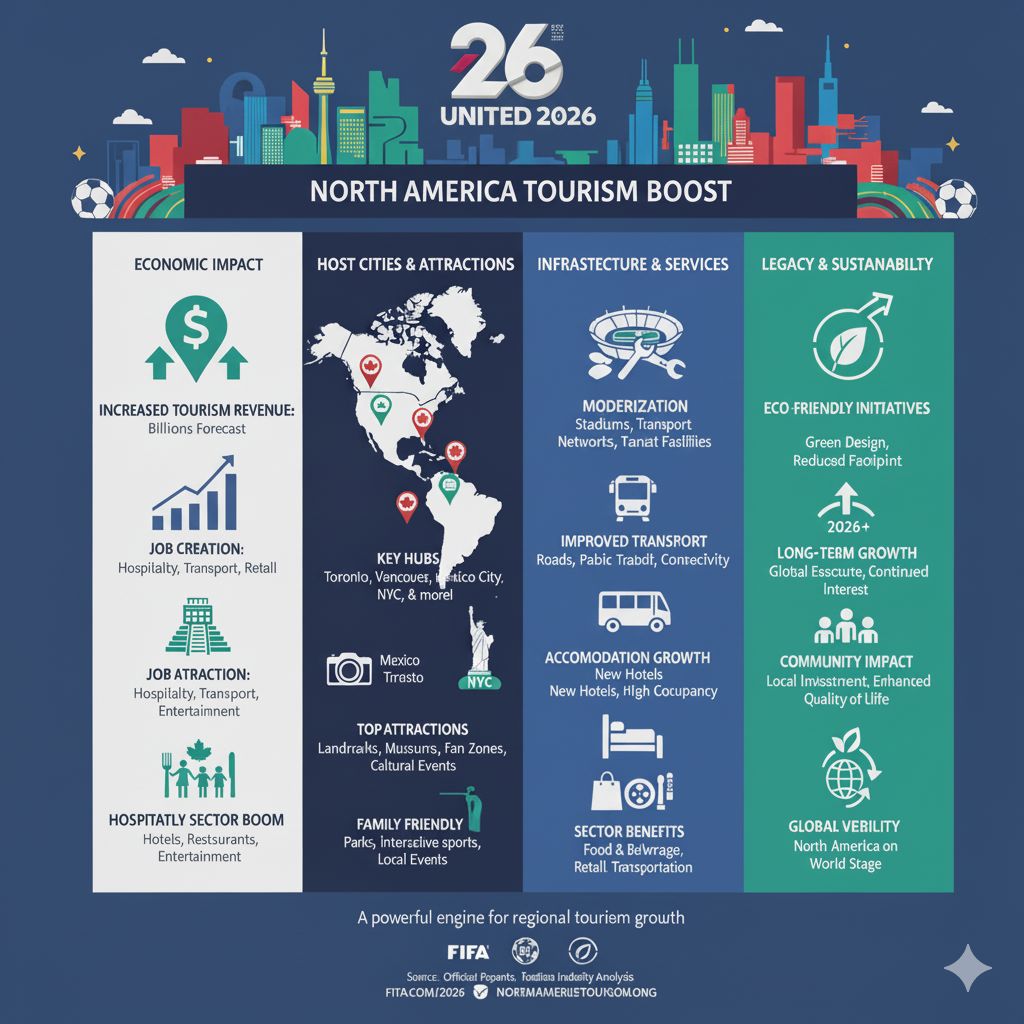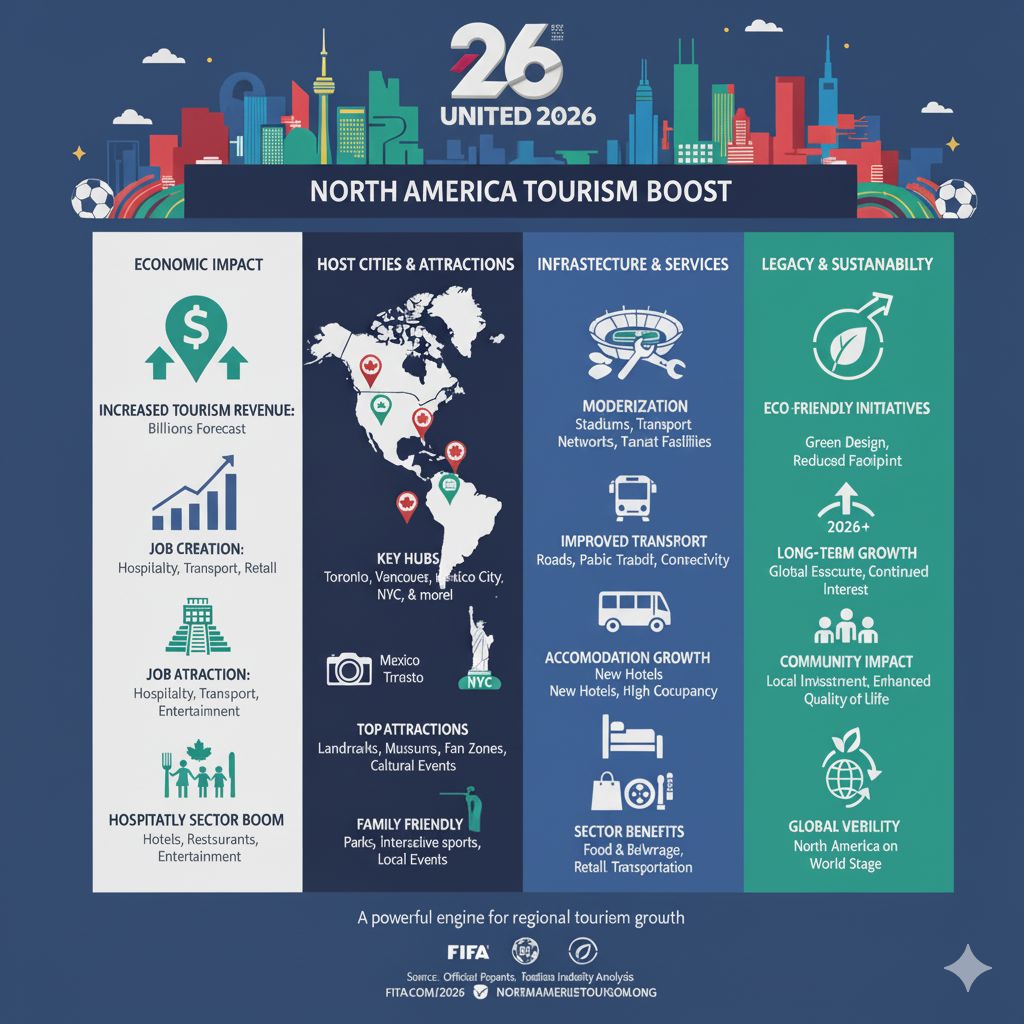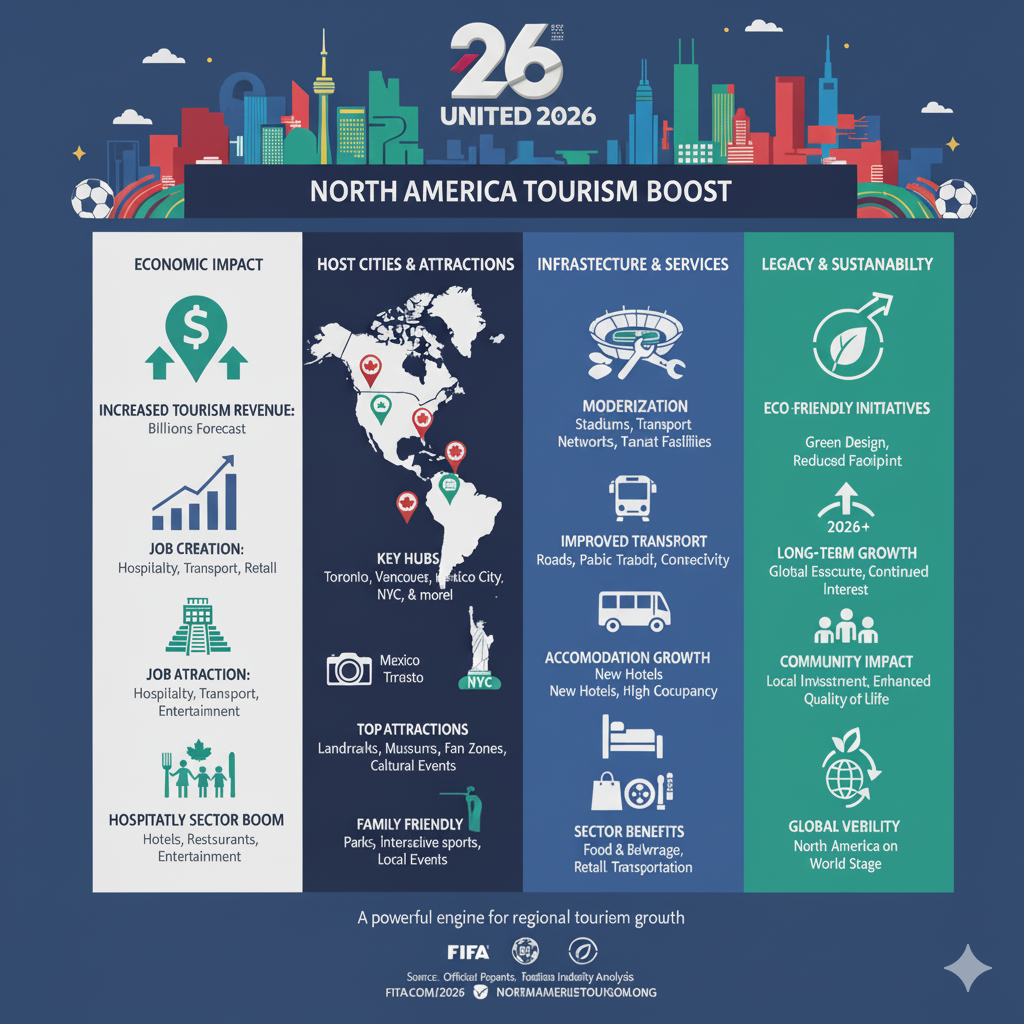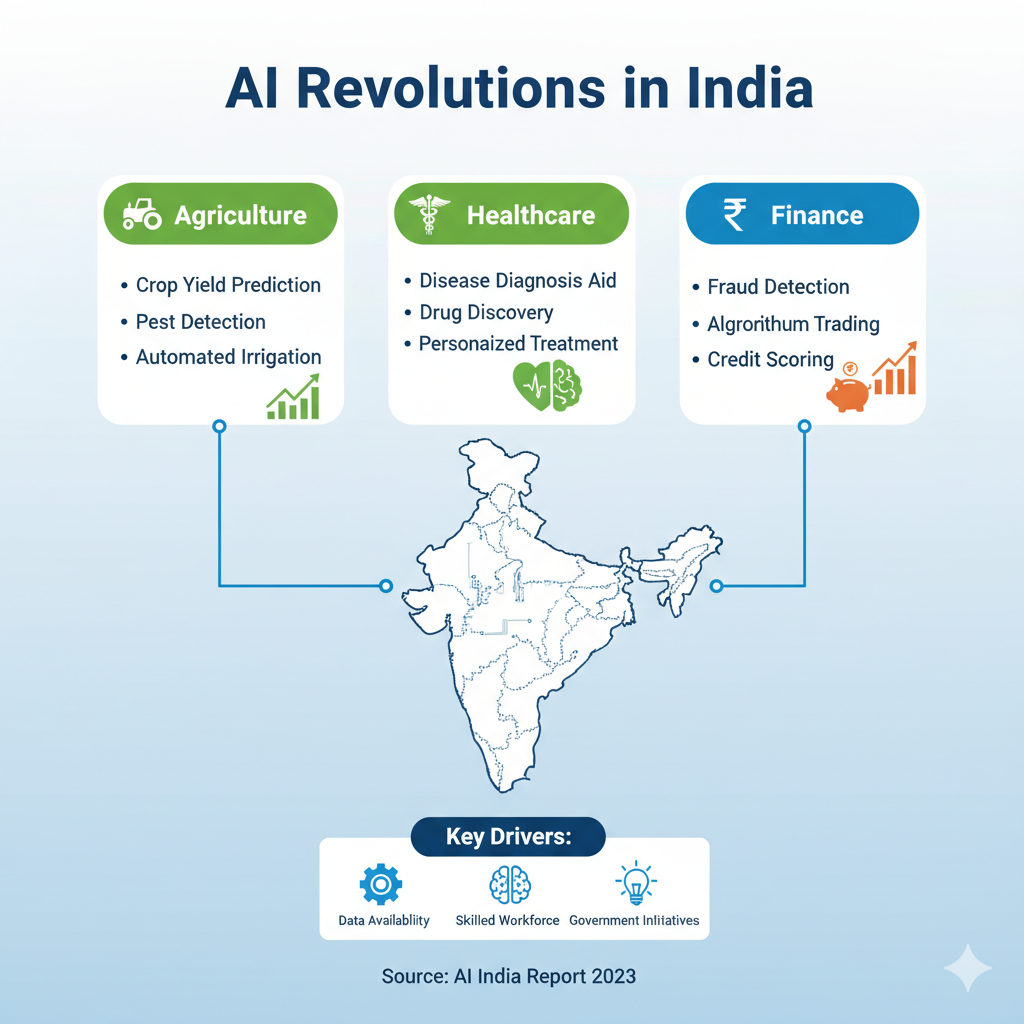The 2026 FIFA World Cup, hosted across the United States, Canada, and Mexico, is poised to be one of the biggest sporting events in history. This mega-event will not only bring extraordinary soccer action but also create significant opportunities to boost tourism in North America. From economic benefits and job creation to improved infrastructure and unforgettable tourist experiences, the 2026 World Cup is set to transform the region’s tourism landscape.
The Economic Impact of FIFA World Cup 2026 on North America Tourism
The FIFA World Cup 2026 economic impact on North America tourism will be profound. Hosting such a large-scale international event forecasts huge tourism revenue for the US, Canada, and Mexico. Studies expect a surge in tourist arrivals, which will drive economic growth in the host cities and beyond.
One major area of focus is job creation from the 2026 FIFA World Cup tourism. The event will generate employment opportunities in sectors like hospitality, transport, retail, and event management. This economic stimulus will flow through local businesses, boosting livelihoods and regional economies.
The economic benefits of FIFA World Cup 2026 for the hospitality industry are especially notable. Hotels, restaurants, cafes, and entertainment venues will experience high demand during the event, contributing to increased revenue and market expansion for these sectors.
Tourism in Toronto During FIFA World Cup 2026 and Other Host City Highlights
Toronto, Vancouver, Mexico City, and multiple U.S. cities will serve as key hubs for the tournament. Tourism in Toronto during FIFA World Cup 2026 is expected to grow significantly as visitors from around the world flock to the city.
How Vancouver tourism will grow with 2026 World Cup highlights the increased visibility and tourist spending expected in this beautiful coastal city. Mexico City’s hospitality sector anticipates a massive boost, given its rich culture and passionate football fan base.
Expected tourist increase in New York City for 2026 World Cup is projected to bring millions of tourists to one of the world’s most iconic cities. The best places to visit during FIFA World Cup 2026 in US cities include famous landmarks, museums, and entertainment districts that tourists will explore beyond match days.
Infrastructure Development Supporting Tourism Growth for FIFA World Cup 2026

Infrastructure development for 2026 FIFA World Cup tourism is a major driver of the event’s tourism boost. Host cities are investing in stadium upgrades, transportation networks, and tourist facilities to accommodate the influx of visitors.
Tourism infrastructure investments for 2026 World Cup North America will enhance accessibility and comfort for travelers, improving their overall experience. How FIFA World Cup 2026 improves transportation for tourists means better roads, transit systems, and connectivity between venues.
Stadiums and tourist attractions for 2026 World Cup visitors will become focal points not only for matches but also for year-round tourism activity. Growth in hotel bookings during FIFA World Cup 2026 North America reflects the anticipated demand spike for accommodations.
Sector-Specific Tourism Benefits from FIFA World Cup 2026
The impact of FIFA World Cup 2026 on North American food and beverage tourism will be evident through diverse culinary offerings perfectly paired with the excitement of the games. Hospitality sector growth during FIFA World Cup 2026 host cities is set to pave the way for international flavor and local business expansion.
Retail tourism boost from 2026 FIFA World Cup in North America will influence shopping districts, souvenirs, and fan gear sales. The transportation sector benefits from FIFA World Cup 2026 tourism by accommodating large groups and ensuring smooth transit during events.
Tourist spending habits during 2026 FIFA World Cup events will show increased expenditure on dining, shopping, entertainment, and tourism activities, positively impacting the local economies.
Tourist Experience and Behavior During FIFA World Cup 2026
What tourists expect during FIFA World Cup 2026 in North America includes vibrant fan zones, cultural festivals, and easy access to match venues. Popular tourist activities during 2026 FIFA World Cup in US and Canada also extend to sightseeing, culinary tours, and local events.
How to plan a trip around 2026 FIFA World Cup matches involves booking accommodations early, purchasing match tickets, and exploring nearby attractions. Family-friendly tourist destinations during FIFA World Cup 2026 will include parks, museums, and interactive sports centers to entertain visitors of all ages.
Cultural tourism opportunities during 2026 FIFA World Cup North America offer rich experiences blending sport and local heritage to create memorable visits.

Sustainable and Legacy Tourism Initiatives for FIFA World Cup 2026
Sustainable tourism initiatives for FIFA World Cup 2026 North America are crucial to minimize environmental impact and preserve host cities’ natural beauty. Legacy tourism benefits after 2026 FIFA World Cup ends include increased awareness and attraction to these cities even after the tournament.
Long-term tourism growth from FIFA World Cup 2026 infrastructure investments supports ongoing visitor interest. Community impact and tourism legacy of 2026 FIFA World Cup highlight how investment in local areas will improve quality of life and tourism potential.
Environmental impact of FIFA World Cup 2026 tourism in North America is managed through eco-friendly policies and smart design to balance growth and sustainability.
Frequently Asked Questions About FIFA World Cup 2026 Tourism Impact
- Will the FIFA World Cup 2026 increase tourist arrivals in North America?
Yes, the event is expected to significantly boost domestic and international tourist arrivals. - Which cities are hosting the 2026 FIFA World Cup matches?
Major host cities include Toronto, Vancouver, Mexico City, New York City, and others across the US, Canada, and Mexico. - How will the World Cup improve tourism infrastructure?
Investments are planned for better stadiums, transportation, hotels, and tourist services. - What kind of jobs will the World Cup create?
Jobs in hospitality, event management, retail, transportation, and tourism services will increase. - How can tourists plan their trips around the World Cup?
Tourists should book early and explore host city attractions alongside matches. - Will family-friendly activities be available during the World Cup?
Yes, many host cities offer parks, museums, and cultural events suitable for families. - How will the World Cup impact the hospitality industry?
Hotels and restaurants will see increased bookings and revenue during the event. - Are there sustainability efforts associated with World Cup tourism?
Yes, organizers are implementing eco-friendly practices to reduce the event’s environmental footprint. - What long-term tourism benefits will host cities gain?
Improved infrastructure and global exposure will encourage continued tourism growth. - Will local businesses benefit from World Cup tourism?
Absolutely, local shops, eateries, and service providers will experience increased demand.
For further insights on the FIFA World Cup 2026 and its impact on tourism, visit official FIFA World Cup 2026 website.
To understand economic forecasts related to the event, see detailed reports by North American Tourism Industry Insights.
For data on infrastructure and hospitality growth related to FIFA World Cup 2026, check out Hotels Magazine’s impact forecast.
In conclusion, the FIFA World Cup 2026 will be a monumental event that is set to elevate the tourism industry across North America. With long-term economic benefits, infrastructure growth, and enhanced tourist experiences, this World Cup promises to be much more than just a soccer tournament—it will be a powerful engine for regional tourism growth and global visibility.



